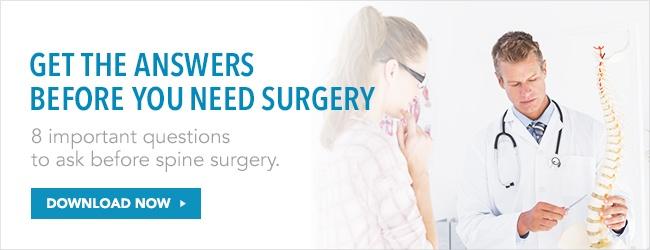Herniated Discs and Bulging Discs: What’s the Difference?
Herniated Discs and Bulging Discs: What’s the Difference? https://phoenixspineandjoint.com/wp-content/themes/psjoints/images/empty/thumbnail.jpg 150 150 Phoenix Spine & Joint Phoenix Spine & Joint https://phoenixspineandjoint.com/wp-content/themes/psjoints/images/empty/thumbnail.jpgDiscs are made out of cartilage and separate the bones of the spine. They work really well as shock absorbers to protect your nerve roots and spinal cord from activities with impact, like running. Discs have two parts. The outer part is really strong; the inner part is softer. It sounds weird, but the inner part is about the same consistency as crab meat, while the outer part is like Goretex. The outer part of the disc dries out over time, and ultimately can tear. Once the outer part is torn, the inner part is free to move through it.
What is a herniated disc?
“Herniated” means an abnormal protrusion. In a herniated disc, the soft inner part of the disc protrudes through a tear in the hard outer part. There are some cool animations of disc herniations on the internet that demonstrate this process. A slipped disc is an older term used to describe a herniated disc, which most people really don’t use anymore.
Herniated discs are common, and they come about in a variety of ways. There can be a long delay between the tear and the herniation, or they can happen all at once. In the major fall or a big car accident, discs are often torn and herniated at the same time. In other cases, an injury causes the tear and then days, months, or years later a minor move like a cough, sneeze, or stepping off a curb causing the herniation.
What is a bulging disc?
 There is a ligament right next to your discs. If the herniated disc material doesn’t make it all the way through the ligament, it is called a bulging disc. If he breaks through it’s often called a herniated disc, or free fragment. Honestly, it usually doesn’t make much difference. Both types can be really painful.
There is a ligament right next to your discs. If the herniated disc material doesn’t make it all the way through the ligament, it is called a bulging disc. If he breaks through it’s often called a herniated disc, or free fragment. Honestly, it usually doesn’t make much difference. Both types can be really painful.
Herniated discs and bulging discs cause several different kinds of pain. Just having a tear in the disc can cause a backache, which feels like a knife in the back. This can go on for years without herniation. The herniation itself usually causes a burning, achy sensation off to the side of the low back with tingling or electrical shock-like feelings going down the leg. The pain down the leg is called sciatica. Sciatica is really severe, scary pain. However, most people will get better on their own without the need for further treatment over days to weeks.
What is the best treatment for a herniated disc?
The best treatment for pain from a herniated disc depends on how long you’ve had it.
In the first six weeks
-
- Do light activity
- Take Tylenol
- Consider acupuncture or chiropractic treatment
- Braces and exercise are not normally effective
- Avoid narcotics and muscle relaxants
- Get back to work ASAP
You can try ibuprofen (2 tablets every 8 hours with food) and Prilosec (one tablet a day) if Tylenol isn’t strong enough. If the leg pain is causing numbness or weakness then get an MRI; most of the time it’s not needed for most people in this phase. If an MRI was done and shows a herniated disc, then one epidural injection may be a good idea. But the main thing is to stay active.
After six weeks
If you are still having pain, then MRI and an epidural may make sense. Physical therapy is also a good idea in this phase. If 12 weeks have gone by and you still have the pain is probably something structural. This is the time to see a surgeon. In nine cases out of ten, it never comes to that.
Most of the time back pain and sciatica due to a herniated disc are scary, but they get better on their own. Hang in there. But please remember, if you have a history or cancer, night sweats, unintentional weight loss, or you can’t pee you can’t wait. You need to be evaluated right away by a doctor.

- Posted In:
- Herniated Disc With Sciatica







